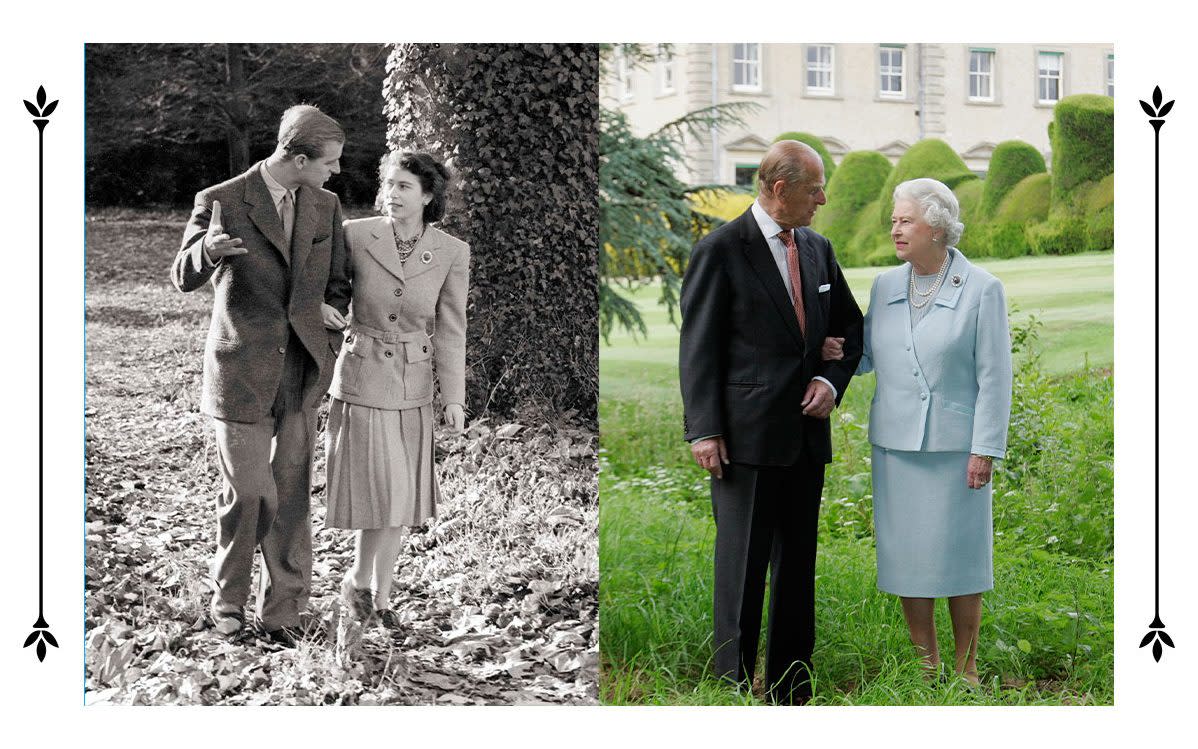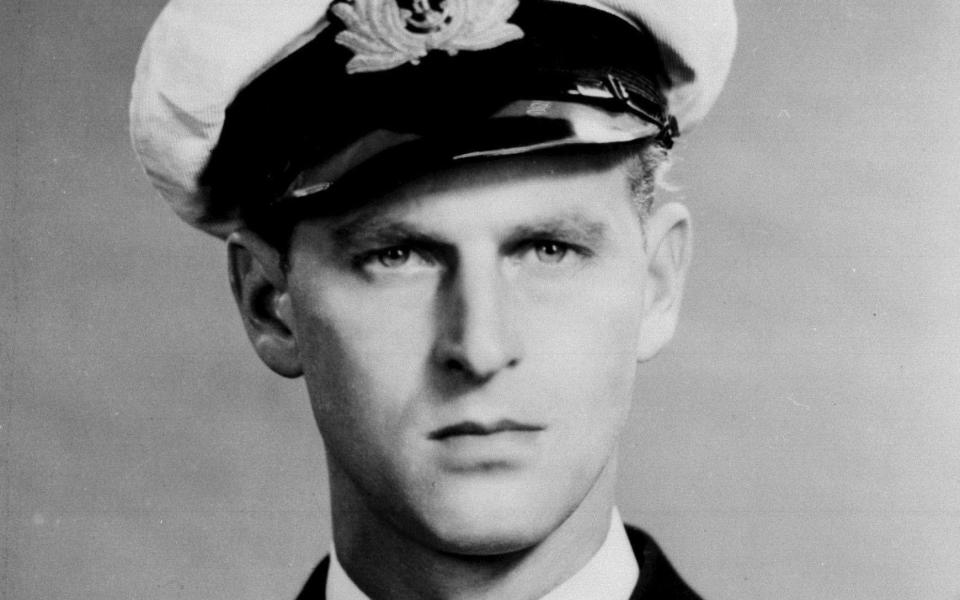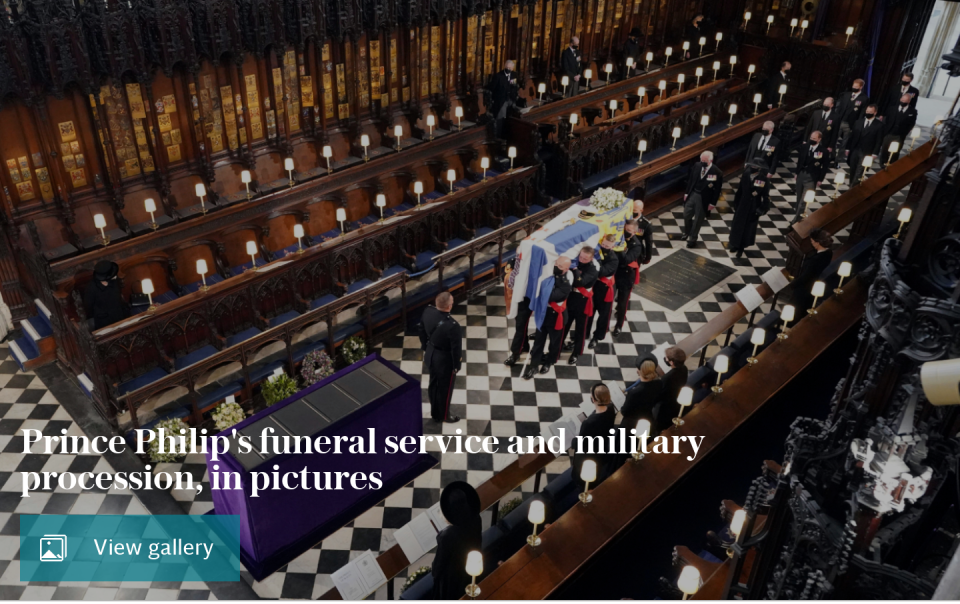'Philip adored his Lilibet. He loved her deeply – you could tell'

- Oops!Something went wrong.Please try again later.
- Oops!Something went wrong.Please try again later.
Since the death of the Duke of Edinburgh, I have spent so much time thinking about him, talking about him, and writing about him, I suppose I shouldn’t be surprised that last night I dreamt about him.
It was a funny dream (he was a funny man) in which I found myself sitting in a cinema with him watching a movie about his life. It starred Hugh Grant as Prince Philip and had a specific title: Four Quotations and a Funeral.
It’s odd that my dream film put the Duke in a starring role because, having known him over forty years, first through working for one of his charities, the National Playing Fields Association and later as his biographer, I know how he despaired at the way his family’s story had been, in his words, “turned into a soap opera by the media”.
He had no desire to be “a character in somebody else’s work of fiction”. The four quotations in this fictional film’s title make more sense, it seems to me, because I have had four particular quotations rattling around in my mind all week.
The Duke of Edinburgh was a voracious reader, especially of military history. Through his paternal aunt Marie Bonaparte, he could claim kinship with Napoleon. Twenty years ago, when I was interviewing him about his own life for a short biography that he had asked me to write to mark his eightieth birthday, I was trying (unsuccessfully) to get him to tell me about his own character, and why he was the person he was.

He avoided answering my questions by pointing me towards something Napoleon had once said: “If you want to truly understand a man, you should look at what the world was like in the year that man turned 21.”
Prince Philip turned 21 in 1942, at the height of the Second World War, when he was serving in the Royal Navy and was mentioned in despatches. To the end of his days Prince Philip epitomised the values, strengths and sense of humour of that cohort – known by some as ‘the greatest generation’ for a reason.
The Duke of Edinburgh did not like talking about himself and he certainly didn’t want to be drawn on his relationship with the Queen. He accepted that the main purpose of his life after 1952 was “to support Her Majesty as best I could”, but was not going to discuss his ‘feelings’ about her with me or anyone else.
When I asked him to tell me about the chemistry between them, he harrumphed, “What sort of a question is that?” When (rather bravely I think) I tried to press him on the matter, he wouldn’t put it in his own words but pointed me towards another quotation.
This was a line by Antoine de Saint-Exupéry, the French author of The Little Prince and admired by Prince Philip as a pioneer of aviation. Prince Philip joined the Royal Navy on leaving school, but he told me emphatically that, left to his own devices, “I’d have gone into the Air Force without a doubt.”
Flying was one of the great unremarked-on passions of his life. Over 45 years, he clocked up a total of 5,986 hours of flying in 59 types of aircraft, including nine helicopters. (An RAF pilot might only clock up 8,000 hours in a full career.)
Prince Philip would happily recall the detail of his first flight, from White Waltham in Berkshire, in a Chipmunk, on 12 November 1952 and of his last, in a BAe 146, flying from Carlisle to Islay, on 11 August 1997 – and acknowledge that it was only because of marrying the Queen that he had these opportunities – but still determinedly refused to reveal anything about the nature of their relationship beyond sharing this quotation from Saint-Exupéry: “Love consists not necessarily in gazing into one another’s eyes, but in looking in the same direction.”
Married – and photographed – for more than 73 years, there are no lovey-dovey pictures of the Queen and Prince Philip holding hands to be found in any picture library anywhere in the world. Public demonstrations of affection were simply not their style, but that theirs was a love match from the start is not in doubt. Every one of their contemporaries to whom I spoke researching my book about Prince Philip agreed on that.
Patricia Mountbatten, his first cousin, who was with him on his wedding day, told me, “He had no doubts at all about Lilibet as a person – as a future wife. He adored her. He loved her deeply – you could tell.” Mike Parker, Philip’s closest male friend at the time and later his private secretary, said to me: “He loved her – absolutely.”
And did that love last? “Oh, yes,” said Gina Kennard, who knew them from childhood - individually and as a couple - for something like 75 years, “They own each other. Nothing could come between them. What they have for one another is the greatest respect – which counts for so much – and deep love. Deep love that goes back a long, long way.”
The Queen and Prince Philip were husband and wife, and good companions with a shared outlook on life, for longer than most of us have lived. They understood one another and they were good for another. Martin Charteris, Princess Elizabeth’s private secretary in 1950 and ultimately her longest-serving courtier, pointed me in the direction of the third quotation that has been on my mind this week. It is a line from The Unquiet Grave by Cyril Connolly: “The true index of a man’s character is the health of his wife.” The Queen is fit and well and will be 95 on Wednesday.
The Queen is a phenomenon. Driven by duty and sustained by faith, her service to the nation has been unparalleled. There has been much in the papers this week about what Prince Philip gave the Queen through their unique partnership – how he was her “strength and stay”, how protective he always was of her, and how he made her laugh.
What has not been noted is what she gave him which he acknowledged to me, almost shyly. She gave the prince the freedom and the opportunity to do all that he did during his long and remarkable life. “It’s been a privilege, I know,” he said. She also gave him something else.

“Refugee prince” is how Philip described himself to me once. His parents were driven into exile in the year he was born; his family broke up before he was ten. He had a peripatetic childhood travelling between relatives in Germany - descendants of whom will be at his funeral - and his British family, but in the 1930s he routinely gave his address as ‘no fixed abode’. Through his teens and his twenties, his boarding school and the Navy were ‘home’. As an adult, his first and only home was the one he found with Princess Elizabeth. He was forever grateful for that.
And now he’s gone and the Queen, dutiful as ever, will carry on through her sadness without him. That is her style. It is what he would have expected of her. And it brings me to the last quotation – something the Queen herself said 20 years ago, in 2001, at the time of the 9/11 terrorist attacks on New York and Washington DC.
In her message of condolence to the American people, she wrote: “Nothing that can be said can begin to take away the anguish and the pain of these moments,” adding, and these are the words that have been in my mind all week: “Grief is the price we pay for love.”
Philip: The Final Portrait by Gyles Brandreth (RRP £25). Buy now for £19.99 at books.telegraph.co.uk or call 0844 871 1514

